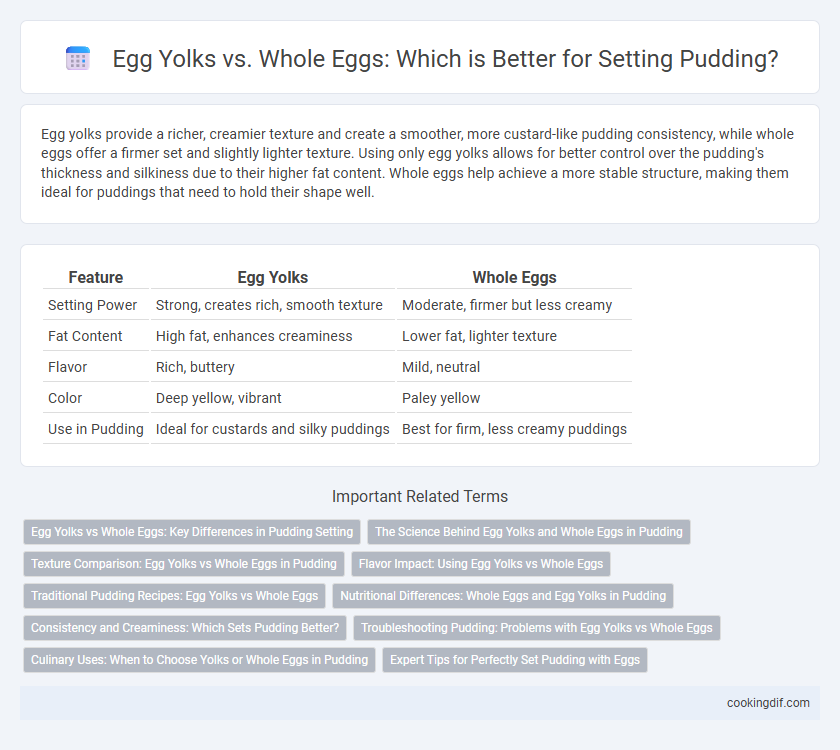Egg yolks provide a richer, creamier texture and create a smoother, more custard-like pudding consistency, while whole eggs offer a firmer set and slightly lighter texture. Using only egg yolks allows for better control over the pudding's thickness and silkiness due to their higher fat content. Whole eggs help achieve a more stable structure, making them ideal for puddings that need to hold their shape well.
Table of Comparison
| Feature | Egg Yolks | Whole Eggs |
|---|---|---|
| Setting Power | Strong, creates rich, smooth texture | Moderate, firmer but less creamy |
| Fat Content | High fat, enhances creaminess | Lower fat, lighter texture |
| Flavor | Rich, buttery | Mild, neutral |
| Color | Deep yellow, vibrant | Paley yellow |
| Use in Pudding | Ideal for custards and silky puddings | Best for firm, less creamy puddings |
Egg Yolks vs Whole Eggs: Key Differences in Pudding Setting
Egg yolks contain higher fat and lecithin levels, which create a richer, creamier pudding with a smooth, custard-like texture. Whole eggs provide more protein, resulting in a firmer, more set pudding but can lead to a slightly rubbery consistency if overcooked. The choice between egg yolks and whole eggs directly impacts the pudding's texture, richness, and overall mouthfeel.
The Science Behind Egg Yolks and Whole Eggs in Pudding
Egg yolks contain a higher concentration of proteins and emulsifiers like lecithin, which create a rich, creamy texture and contribute to a smooth, stable pudding structure. Whole eggs add both egg whites and yolks, with egg whites providing structure through coagulation but potentially leading to a firmer or rubbery texture if overcooked. The balance between yolk proteins and white proteins determines the pudding's final consistency, with yolks promoting tenderness and silkiness, while whole eggs increase firmness and set strength.
Texture Comparison: Egg Yolks vs Whole Eggs in Pudding
Egg yolks produce a richer, creamier texture in pudding due to their higher fat content and emulsifying properties, resulting in a smoother and silkier consistency. Whole eggs contribute to a firmer and more custard-like set because the egg whites provide additional protein that strengthens the pudding's structure. Choosing between egg yolks and whole eggs depends on the desired balance between creaminess and firmness in the final pudding texture.
Flavor Impact: Using Egg Yolks vs Whole Eggs
Egg yolks contribute a richer, creamier texture and a more decadent flavor to pudding due to their higher fat content, enhancing overall taste and mouthfeel. Whole eggs provide a balanced structure and a milder flavor, resulting in a firmer set but with less richness compared to yolk-only recipes. Choosing egg yolks over whole eggs intensifies the custard-like qualities and delivers a silkier, more luxurious pudding experience.
Traditional Pudding Recipes: Egg Yolks vs Whole Eggs
Egg yolks provide a richer texture and creamier consistency in traditional pudding recipes due to their higher fat content and natural emulsifiers. Whole eggs contribute to a firmer set and slightly lighter texture because of the egg whites' protein coagulation, which helps stabilize the pudding. Choosing egg yolks versus whole eggs influences the pudding's richness, mouthfeel, and firmness, with yolks favored for custard-style desserts and whole eggs for more structured, baked puddings.
Nutritional Differences: Whole Eggs and Egg Yolks in Pudding
Egg yolks provide a rich, creamy texture to pudding and contain higher levels of fat, cholesterol, and essential vitamins like A, D, E, and K, which contribute to a smoother consistency and enhanced flavor. Whole eggs include both yolk and white, offering more protein and less fat, resulting in a firmer set with a slightly lighter texture. Choosing yolks or whole eggs impacts the pudding's nutritional profile, affecting calorie content, richness, and mouthfeel.
Consistency and Creaminess: Which Sets Pudding Better?
Egg yolks provide a richer, creamier texture to pudding due to their higher fat content and natural emulsifiers, resulting in a smoother, silkier consistency. Whole eggs contribute to a firmer set because the egg whites contain proteins that coagulate more firmly upon heating, but this can lead to a slightly more rubbery texture. For optimal pudding consistency and creaminess, egg yolks are preferred, while whole eggs are better suited when a sturdier set is desired.
Troubleshooting Pudding: Problems with Egg Yolks vs Whole Eggs
Egg yolks provide a richer, creamier texture and help pudding set with a smooth custard consistency, while whole eggs contribute to a firmer, more gelatinous structure but risk curdling if overheated. Troubleshooting pudding involves controlling temperature precisely; overheating mixtures with whole eggs often leads to grainy textures, whereas yolk-based puddings require careful tempering to prevent scrambling. Understanding the different coagulation temperatures--around 149degF (65degC) for yolks and 155degF (68degC) for whole eggs--ensures optimal pudding set and prevents common problems like weeping or over-thickening.
Culinary Uses: When to Choose Yolks or Whole Eggs in Pudding
Egg yolks provide a rich, creamy texture and thicker consistency in puddings, ideal for custard-style desserts requiring smoothness and stability. Whole eggs create a firmer set with a lighter, more balanced structure, suitable for baked puddings or those needing a delicate but sturdy gel. Choosing yolks enhances richness and silkiness, while whole eggs offer versatility and a more resilient texture in pudding recipes.
Expert Tips for Perfectly Set Pudding with Eggs
Using egg yolks instead of whole eggs in pudding yields a richer, creamier texture due to higher fat content, which expertly sets the pudding without toughness. Whole eggs provide a firmer structure and stability, ideal for custards needing a more solid set, but risk a rubbery finish if overcooked. For perfectly set pudding, balance yolks and whole eggs by following precise cooking temperatures--between 70-80degC (158-176degF)--to prevent curdling and achieve smooth consistency.
Egg yolks vs Whole eggs for setting Infographic

 cookingdif.com
cookingdif.com